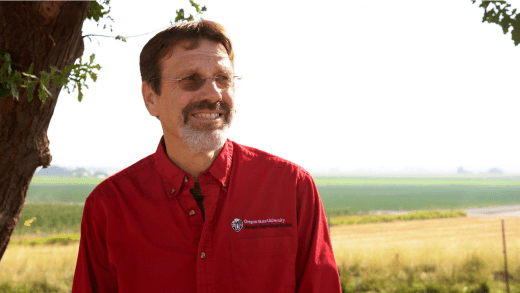At the height of World War II, Oregon farmers asked Oregon State College to establish a research station in the town of Ontario. As a result, the Malheur Experiment Station (MES) was created in 1942 with a primary emphasis on sugar beet production as part of the war effort. The facility quickly became a leader in agricultural innovation and region specific, research-based solutions for farmers that improved crop production, profitability, and sustainability. Today Oregon State College is known as Oregon State University, and the now 117-acre MES is a branch of OSU’s College of Agricultural Sciences. The station also conducts research for Malheur County’s other major crops including onions, wheat, corn, beans, potatoes, small grains, and native plants.
“Sugar beets have been in the station’s DNA from the start,” said MES director Stuart Reitz. “We work with growers in Malheur County and the rest of the Treasure Valley, which extends into the neighboring areas of southwest Idaho. We stay in close contact with them so we can understand the issues they face and develop research projects to address their needs.”
Reitz, who was born in New Orleans and grew up mostly in Mobile, Ala., loves the outdoors and has always been fascinated by nature. After receiving a bachelor’s degree in biology from the University of South Alabama, Reitz attended Clemson University in South Carolina where he obtained a master’s degree studying bird migration.
“One of my advisors for my master’s degree was Peter Adler, an entomologist. He encouraged me to get into entomology, and I eventually took him up on it,” Reitz said. “I wound up doing my PhD with Peter on a biological control-oriented project, which was studying how parasitic flies interact with their caterpillar hosts. Those tachinid flies do some pretty interesting things. The caterpillars they parasitize are corn earworms, which burrow into the ears of corn and are everyone’s least favorite pest of sweet corn, tomatoes, cotton, and other crops. It sparked my interest that I could do research that was interesting biologically and necessary for helping to solve problems for growers.”
After finishing his PhD, Reitz moved to Riverside, Calif., to do postdoctoral research with John Trumble.
“We worked on Integrated Pest Management (IPM) systems for vegetable crops in California,” he said. “I then worked for USDA’s Agricultural Research Service (ARS) as a research entomologist in Tallahassee, Florida and did IPM for vegetable crops in the southeast.”
According to Reitz, IPM is often referred to as “using all the tools in the toolbox” to manage agricultural pests.
“There are no ‘silver bullets’ that will successfully manage any pest for the long haul. Therefore, it is important to continually improve and grow the tools we have for pest management,” he said. “IPM is also holistic in attempting to manage all the pests, such as insects, weeds, pathogens, across a farm so that how you manage one pest doesn’t end up creating worse problems with another pest. When looking at IPM in that holistic way, you realize it might be better to shift the focus from the pest (IPM) to define IPM as ‘Intelligent Plant Management.’”
After 13 great years with USDA-ARS, Reitz felt it was time to try something different. He accepted a position with OSU and became director of the MES in 2018.
“Oregon agriculture is incredibly diverse with some 200 crops grown in the state. Oregon is also a bit special because it has a large sugar beet growing area on the east side of the state while the Willamette Valley on the west side is the headquarters for beet seed production,” said Reitz. “Thanks to mild spring temperatures in Malheur County, our growing area ranks pretty high in terms of yield and sugar content. In addition to Mother Nature, we also have really good growers who know what they’re doing.”
Malheur County’s high desert environment also poses unique challenges for sugar beet production.
“The climate can be challenging. Beets are planted early and harvested late, and growers sometimes joke about making sure to plant them early enough in order to have time to replant them after a spring freeze,” Reitz said. “There are some years when the beet harvest can be a cold, wet and muddy operation. In between, we have hot dry summers, so irrigation supplies are always a concern.”
The MES meets the challenges facing growers head on by conducting yearly crop trials and publishing the results in an annual report. These trials have led to many discoveries and groundbreaking innovations in sustainable techniques that have greatly improved agriculture in Malheur County. (2)
“Sugar beets are the epitome of a Goldilocks crop in terms of nitrogen fertilization. Too little reduces yields. Too much nitrogen produces a very lush plant, but that comes at the cost of sugar content and lower processing quality. Too much nitrogen is also an economic cost for growers and an environmental cost when residual nitrogen in the soil leaches into groundwater supplies,” said Reitz. “Research led by Clint Shock over the years at MES has optimized fertilization practices to get to the ‘just right’ amount of nitrogen so growers are able to produce a high-quality crop without wasting their money and minimizing risks to groundwater.”
The weed management program at MES is one of the facility’s greatest achievements and contributions to sugar beet research, according to Reitz.
“The station has long had a weed scientist on staff. Over the years, Charles ‘Chuck’ Stanger, Corey Ransom, and Joel Felix have led the weed management program because, as a recent paper from Joel and his colleagues has shown, sugar beet growers can lose 80 percent of their crop without weed management,” he said. “Joel has done research on optimizing weed management in sugar beets and is currently monitoring the recent introduction of Palmer amaranth into the Treasure Valley. He and his colleagues are working on management plans to hopefully keep it from becoming the devastating weed it is elsewhere.”
In addition to sugar beets, the MES also does considerable research on onions, potatoes, wheat, dry beans and corn.
“There are three faculty members at the station. Joel Felix is a weed scientist, Udayakumar Sekaran works on irrigation and fertility management, and I’m an entomologist,” said Reitz. “One of the professional benefits of being at a small station is the opportunity to grow in new research areas. In addition to insects, I’ve had the opportunity to work in areas such as produce safety, plant pathology, and most recently, methods to dispose of used irrigation drip tape.”
For Reitz, the greatest rewards of the research and extension programming he oversees are seeing information developed through MES research and delivered through its outreach efforts being put into practice. He feels the biggest challenges facing the American sugar industry are prioritizing weed management and supporting the next generation of farmers by providing them with high quality research.
“We should be concerned about the next generation of farmers. We have a number of talented, passionate younger growers in our community, but with the continuing consolidation in agriculture, it is harder for a young person to step in and take the place of someone who retires,” Reitz said. “I want to see new and existing growers be successful, so I’m an advocate for research. I appreciate the support the station receives from our local grower association and our industry partners for research. I view research funding not just as an expense but as an investment that has significant returns for growers, the industry, and the general public.”
Reitz is also passionate about giving the public a firsthand view of the MES.
“We enjoy having people visit the station to learn about our research. A few years ago, we had the entire student body from the elementary school in Plush, Ore., come to the station—all six of them!,” he said. “We had a great time letting the kids wander around our demonstration plots to learn about plants and insects in the field and then teaching them how to set siphon tubes. I think we got more soaked than any of the plants they were trying to irrigate.”
Reitz strongly encourages all young people interested in agriculture, entomology and research to get involved.
“There is no time like the present,” he said. “If there’s a research station or extension office in your town, give them a call to find out about internships or summer jobs. Believe me, there are opportunities; I’m always looking for bug counters. It’s valuable to get some experience to see what interests you and then use that first opportunity as a steppingstone for additional opportunities.”
When he is not at the MES, Reitz enjoys spending time outdoors with his wife Katzy, their two sons and the family dogs. He also enjoys cross country skiing around the MES trial plots in the winter.










Get Social with #MoreToSugar